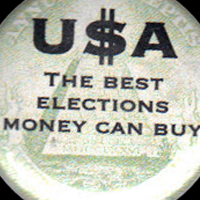Big Donors Dominated California Congressional Primaries in 2014

Mirroring political fundraising across the country, big donors dominated the state’s congressional primaries this year, according to a new study (pdf) by the California Public Interest Research Group (CALPIRG)
More than 34,000 small donors in the state were outspent by just 864 large donors, the 10th largest ratio of big donors to small donors in the country. Texas ranked No. 1 by having one single large donor outspend 8,767 small donors.
Sixty-seven percent of California’s $43,911,097 in primary contributions came from big donors. Again, Texas was No. 1, with big donors accounting for 80% of contributions. California’s percentage of large-to-small-donors pretty much matched the national average. Nationally, fewer than 5,500 large donors matched primary contributions from around 440,000 small ones.
Large donors were defined as those spending $1,000 or more in one race and small donors as spending $200 or less. The analysis was based on data from the Center for Responsive Politics, which based its information on data from the Federal Election Commission. Louisiana was not included in the research because it holds its primary on Election Day.
It wasn’t always this way. The U.S. Supreme Court opened the money spigot in 2008 when it equated money with speech in Citizens United v. Federal Election Commission and gave big money a big megaphone. The court assumed that transparency would mitigate untoward influence by rich people and that the scales had not been tipped in anyone’s favor.
It hasn’t worked out that way.
“Some argue about which party benefits the most from the new Wild West of campaign finance, or claim that so long as both major candidates in an election are well-financed, our democracy is working the way it should,” Zach Weinstein, Campaign Organizer with the CALPIRG Education Fund, said. “But that misses the forest for the trees: small donors’ voices are increasingly drowned out by the spending of a small cadre of large donors, and ordinary citizens are the ones who lose out.”
CALPIRG did not take into consideration the contributions of Super-PACs, which are often dominated by out-of-state interests and cloaked by campaign finance rules to protect donor identities. Despite a growing awareness that large sums of unaccounted for money is reshaping the political landscape in a country with growing income inequality, the high court continues to increase the shield around moneyed interests.
In April, the court struck down limits on aggregate donations to individual candidates, a ruling that has forced states to rewrite their own campaign finance laws. The court said a donor still couldn’t give more than $2,600 to a candidate in a federal election, no more than $5,000 a year to a single political action committee (PAC) and no more than $32,400 to a national party committee.
But states could no longer put an aggregate limit on how many of these candidates and groups a single donor could give their money. California was not one of 12 states with aggregate limits.
–Ken Broder
To Learn More:
Big Donors Dominated California Congressional Primaries, Report Says (by Jean Merl, Los Angeles Times)
GOP Leads the Charge to Kill State Campaign Finance Reform Measures (by Ken Broder, AllGov California)
Supreme Court’s Lifting of Campaign Donation Caps Ripples Down through the States (by Steve Straehley, AllGov)
Big Money Dominates in Congressional Primaries (California Public Interest Research Group) (pdf)
- Top Stories
- Controversies
- Where is the Money Going?
- California and the Nation
- Appointments and Resignations
- Unusual News
- Latest News
- California Forbids U.S. Immigration Agents from Pretending to be Police
- California Lawmakers Urged to Strip “Self-Dealing” Tax Board of Its Duties
- Big Oil’s Grip on California
- Santa Cruz Police See Homeland Security Betrayal in Use of Gang Roundup as Cover for Immigration Raid
- Oil Companies Face Deadline to Stop Polluting California Groundwater





